This appeared in the August 22, 2003 Chicago Reader, and has more recently been reprinted in the excellent Camera Lucida. On the afternoon of September 17, 2014, in Sarajevo at the Film.Factory, I screened this for the MA students and assigned them to create five-minute remakes. We screened most of the results nine days later at a party, and they were really dazzling — and all quite different from one another. — J.R.
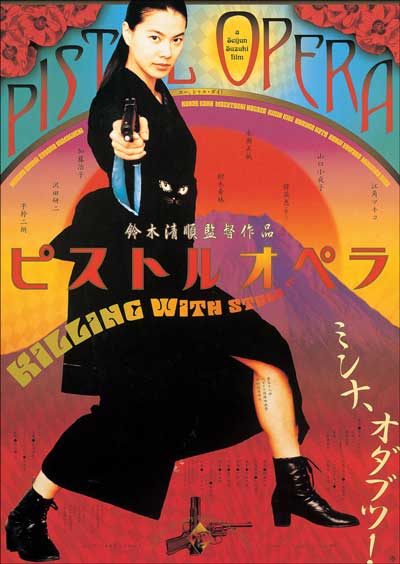
Pistol Opera
**** (Masterpiece)
Directed by Seijun Suzuki
Written by Kazunori Ito and Takeo Kimura
With Makiko Esumi, Sayoko Yamaguchi, Masatoshi Nagase, Kan Hanae, Mikijiro Hira, Kirin Kiki, Haruko Kato, Yeong-he-Han, and Jan Woudstra.
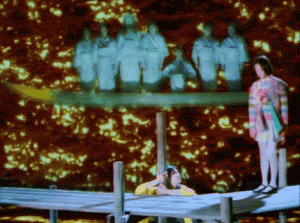
Can I call a film a masterpiece without being sure that I understand it? I think so, since understanding is always relative and less than clear-cut. Look long enough at the apparent meaning of any conventional work — past the illusion of narrative continuity that persuades us to overlook anomalies, breaks, fissures, and other distractions we can’t process — and it usually becomes elusive. Yet it’s also true that we have different ways of comprehending meaning. I once watched some children listen to passages from James Joyce’s Finnegans Wake, possibly the most impenetrable book in the English language, and saw them burst into giggles, plainly understanding better than the adults that this was exactly the way grown-ups talked, only funnier. Read more
The following was commissioned by and written for Asia’s 100 Films, a volume edited for the 20th Busan International Film Festival (1-10 October 2015). — J.R.

To explain why Lee Chang-dong’s extraordinary Poetry (2010) is my favorite Korean film, I first need to confess to a feeling of alienation from a good many other South Korean films and what I regard as their excessive reliance on rape and serial killers as subjects. Admittedly, these themes are by no means restricted to South Korean cinema or even more generally to Asian cinema, but they also help to account to my resistance to such highly praised European touchstones involving rape as Ingmar Bergman’s The Virgin Spring and Luchino Visconti’s Rocco and His Brothers (both 1960), and such American films regarding serial killers as Jonathan Demme’s The Silence of the Lambs (1991) and Ethan and Joel Coen’s No Country for Old Men (2007). The tendency of all these films to exploit and/or sentimentalize these subjects is scrupulously avoided by Lee and handled throughout with tact, delicacy, and a finely nuanced sense of development in its heroine’s ethical and aesthetic consciousness. Consequently, Poetry offers a profound social critique by addressing the theme of rape and its role in Korean society quite directly,
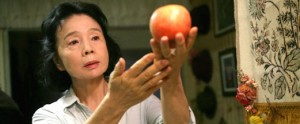
The film centers on the suicide by drowning of a suburban, small-town schoolgirl who had been raped by several of her teenage classmates. Read more
How film history gets rewritten
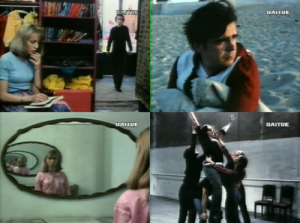
I realize it must sound crazy for people who haven’t seen Jacques Rivette’s 750-minute Out 1 (1971) or his 255-minute Out 1: Spectre (1972) to keep reading blog posts about them — even though I keep hearing almost every day from various others who have seen either or both films recently, in Chicago or New York or Vancouver or Berkeley, and are still recovering from the experience.
What I’d like to focus on here is how these films wind up getting misrepresented due to the circulation of incomplete data. For instance, everyone who’s seen any stills from the two films and hasn’t seen the films probably concludes that they’re both in black and white. They’re wrong; the problem is that the only photos available from the films on the Internet and in film magazines are in black and white, undoubtedly because color stills would cost too much money to process. In fact, the beautiful restoration of Spectre that showed at the Gene Siskel Film Center last Saturday, blown up from 16-millimeter to 35, had far more luscious and luminous colors than any other print I’ve ever seen — finally justifying Rivette’s supposedly extravagant claim in a 1975 interview that “you might almost say that I am trying to bring back the old MGM Technicolor!
Read more
From Cinema Scope #16 (Fall 2003). — J.R.
One of the more fascinating things about the linguistic options of DVDs in relation to their nationality is how often they confound expectations. It would appear that few countries show more indifference to other countries and their languages than the U.S., yet the DVDs with the greatest number of subtitling and dubbing options are often those on American labels. Conversely, when I visited Japan twice in the late 1990s, I was impressed by the cottage industries devoted to teaching foreign languages, which ranged from prime-time TV shows teaching conversational “business” English and Spanish to bilingual movie scripts sold in bookstores, some of them packaged with videos of the same films. But my recent efforts to hunt for Japanese DVDs with English or French subtitles have been in vain -— which is all the more frustrating when I come across listings for box sets devoted to Kiarostami and Godard’s Histoire(s) du Cinéma.
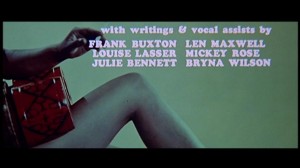
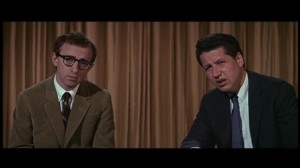
Attending Cinema Ritrovato, an archival film festival, in Bologna last summer, I went hunting for Italian DVDs and quickly discovered that those with Italian movies almost never come equipped with English subtitles (the restoration of The Leopard, which I noted in my last column, is a rare exception). Read more







